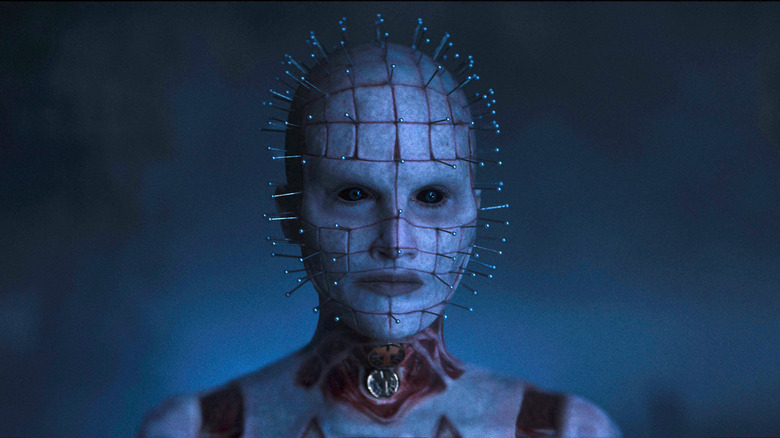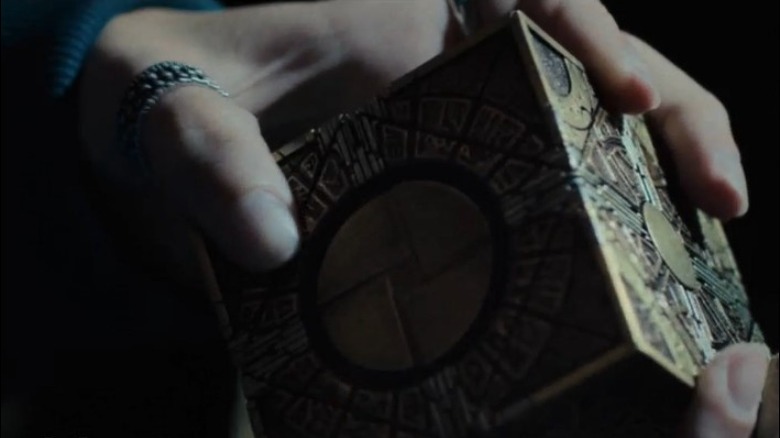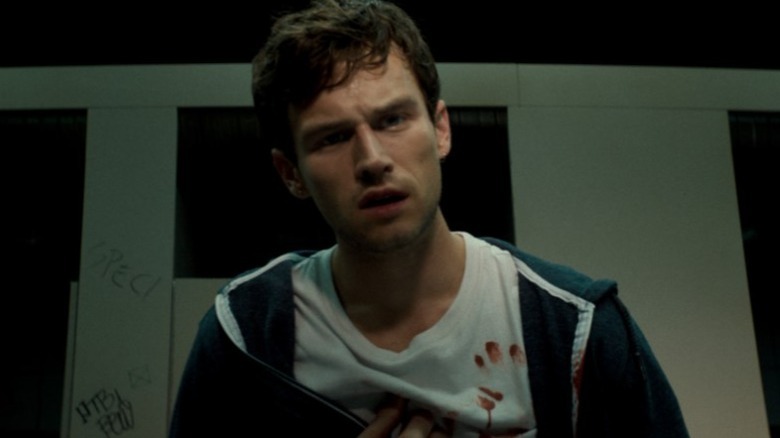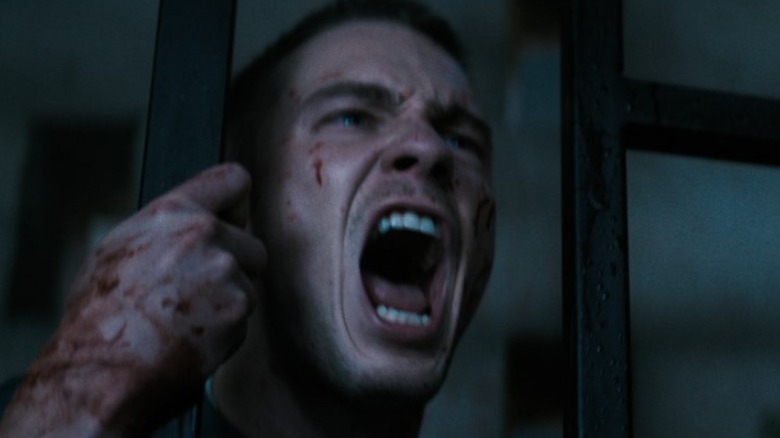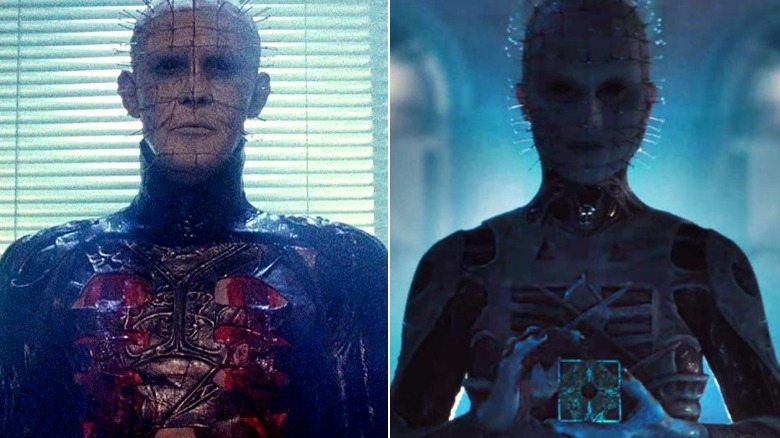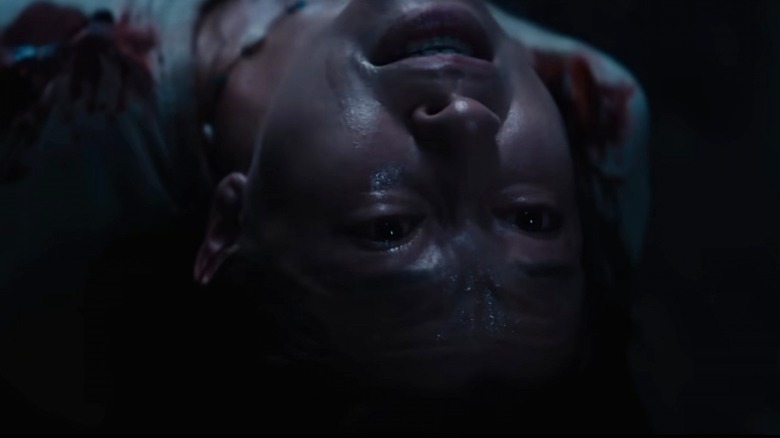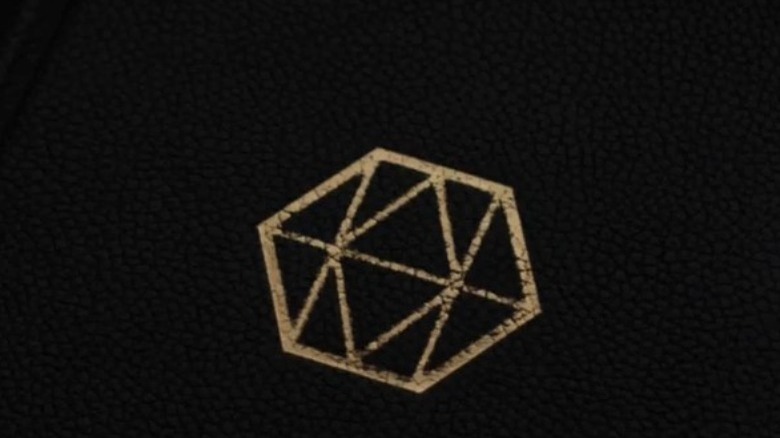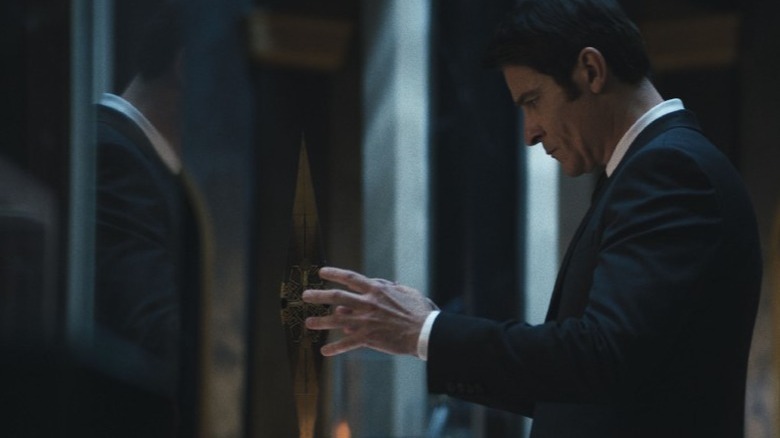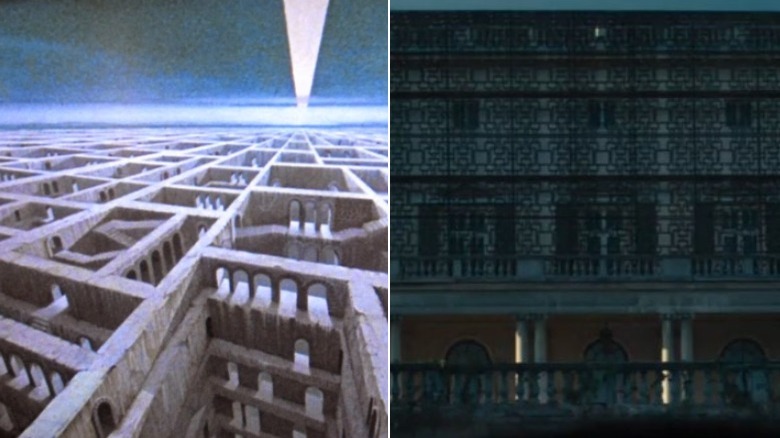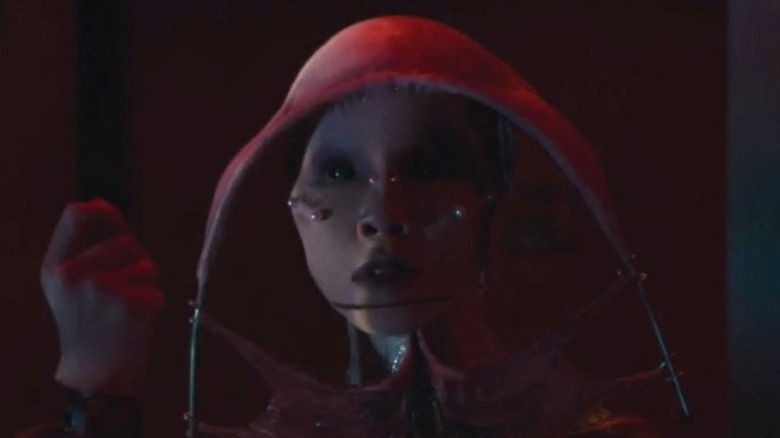Small Details You Missed In Hulu's Hellraiser
This post contains spoilers for "Hellraiser" (2022).
"What do you pray for?" If a creepy demonic figure with pins in her head asks you that question, don't answer it. It's all a trick. "Hellraiser" returns with a 2022 Hulu reboot to torment us all with enough flesh-peeling, blood-soaked imagery to last a lifetime. The Hell Priest, Pinhead, is back, too, and more sinister than ever. Doug Bradley has passed the reins (or should we say, chains) over to Jamie Clayton for the role of the horror icon. Her blackened eyes are as dark as the void brought about by the fabled Lament Configuration. She and her fellow Cenobites are relentless in their pursuit of blood and hellish torture. It's up to Riley (Odessa A'zion) to find a way to bring the terror to an end without sacrificing her friends along the way.
This Hulu original propels "Hellraiser" forward for a new generation. With 10 other films in the franchise, including classic horror staples as well as a few cinematic stinkers, the latest film will surely renew interest in the three-decades-old franchise. Like every honest reboot, the filmmakers often set out to redefine the original work through a different lens while still honoring what fans loved about the franchise as a whole. Director David Bruckner does just that. "Hellraiser" reveres the legacy of the Cenobites and their accursed puzzle box while laying the groundwork for an entirely new narrative within that world. As such, attention to detail is key. Throughout the film, there are several details that buoy up the unfolding horror and recall the "Hellraiser" legacy. Some of these details might be overlooked upon initial viewing, but don't worry: Let's go through some of the most noteworthy details in the film.
Lament Configuration iconography
Perhaps, one of the most important and memorable relics of the "Hellraiser" franchise is the enigmatic puzzle box that torments any soul too curious to let sleeping dogs lie. The Cenobites are summoned into the realm of mortals only after an unsuspecting soul completes a puzzle known as the Lament Configuration. Of course, the rebooted film on Hulu provides far more clarification on what the Lament Configuration actually means than the litany of films that preceded it, showing that there are a variety of solutions and arrangements that yield different results, as well as a small blade concealed in the box to shed the user's blood. But within the film, you might notice the production design contains many allusions to cubes besides the iconic demon box itself.
The reboot doesn't shy away from offering countless visual cues that recall the Lament configuration. For starters, the relic is kept in a perfectly square safe in an empty container. Within the safe, the box holding the demon-summoning artifact is also cubic in shape. Once Riley and Trevor make their way to the wealthy Mr. Voight (Goran Visnjic) estate, the building, while not perfectly square, as that'd be bizarre, evokes the puzzle cube iconography with its nearly cubic (slightly rectangular) design. The ceiling window of the manor is also a perfect square and is the means by which Voight and Riley view the emergence of the diamond-shaped God Leviathan entering the physical world. The repeated visual allusions to mazes and labyrinths also recall the design of the puzzle box itself.
Foreshadowing Matt's demise
From the get-go, we understand that Riley is going to endure a hellish ordeal at the hands of the Cenobites. As a drug addict, she's constantly being criticized but cared for by her brother, Matt (Brandon Flynn). She clearly has a history of self-destructive behaviors. From the start of the film, Matt shows just how protective of his sister he is when stating his dislike for her new boyfriend, Trevor (Drew Starkey). Of course, we wouldn't know how right Matt actually is about Trevor until third act of the film. Still, Matt knows that Riley is prone to sporadic decisions that are ultimately guided by her dependence on substances. Unfortunately, the writing is on the wall. Everyone around Riley will become collateral damage in her struggle to end the nightmare that the Lament Configuration starts.
After Matt and Riley fight, causing the former to kick the latter out of the house, Riley becomes a bit of a drifter, hitting the streets with nothing but her possessions. One of those possessions is the recently acquired puzzle box. The obvious indication that Matt will be the first to succumb to the box is the nightmarish dream he has depicting chains latching onto him. There are also other clues, such as when he passes by a tow truck with chains rattling from the back. The film often uses smaller details like the tow truck to signal the coming of future events. Perhaps the painful deaths of those closest to Riley were fated all along.
If you or anyone you know needs help with addiction issues, help is available. Visit the Substance Abuse and Mental Health Services Administration website or contact SAMHSA's National Helpline at 1-800-662-HELP (4357).
Trevor mirrors the Trevor of Hellseeker
"Hellraiser" is a franchise rife with humans just as monstrous as the demonic figures that emerge to cause torment. The first film focuses on Frank Cotton (Sean Chapman), a man twisted up in his own selfish desires. After having an affair with his brother's wife, he is seemingly killed by the Cenobites after solving the puzzle box. Later, a small sampling of his brother's blood brings him back to life — partially. Frank uses his former flame, Julia (Clare Higgins), to bring him sacrificial lambs in the form of dates she has seduced to help him rejuvenate fully. He eventually betrays Julia. In the second film, Julia is resurrected by Dr. Phillip Channard (Kenneth Cranham). She uses him just like Frank used her in the previous film. She ultimately betrays Dr. Channard. See the pattern here?
In the sixth film, "Hellraiser: Hellseeker," Kirsty Cotton (Ashley Laurence) returns to the franchise. Now, she is married to a man named Trevor (Dean Winters). However, she suddenly dies in a car accident. The film's big reveal is that Trevor plotted the death of his wife for her inheritance. Trevor is the one who perished in the car accident, not Kirsty. She offered the Cenobites Trevor in exchange for her own life. The film is essentially Trevor just living in his own version of hell. Hulu's "Hellraiser" features another man by the name of Trevor, this time played by Drew Starkey, who happens to be Riley's newest boyfriend. Fans who are familiar with the "Hellraiser" franchise and picked up on a detail as simple as Trevor's name may have actually seen the reveal of his deceit coming. He was hired by Voight to lure Riley and her friends into being the human sacrifices for the box.
Pinhead's torn flesh resembles the Doug Bradley version
Stylistically, there aren't quite any other creatures in cinema like the Cenobites of "Hellraiser" fame. These tormented souls were once human but have been transformed into monstrosities who are the epitome of human suffering. Their bodily mutilations represent the worst pain a body can endure, and they often have a connection to whoever the person was in life. The Cenobites of the classic films were often draped in black leather, which was, perhaps, one design choice that could only originate in the '80s. The Cenobites of the latest "Hellraiser" received a bit of a modern update. Gone are the leather duds of a bygone era. Instead, the Cenobites' designs are even more heavily focused on the horrific modifications made to their bodies.
Pinhead, for example, retains the demon's namesake, with sharp nails or needles plunged into every square inch of the Cenobite's head. Below, the neck, chunks of flesh are stripped away and peeled back. These sections of absent skin along the demon's chest actually resemble the tight leather strap design of the Doug Bradley version of Pinhead. If you look closely, you can see how the mutilations carved into the demon's flesh are an homage to the movie monster's design of old. It's just another way in which Hulu's "Hellraiser" endeavors to keep the spirit of the franchise alive even in the subtlest details.
Matt's skinned mirror image references the fates of Frank and Julia
The Cenobites don't play around. Whenever the box claims someone's blood, they come to collect. But what happens to the poor souls who seemingly die at the hands of these interdimensional beings? The classic series often framed this other dimension as hell. As such, the victims of the Cenobites were trapped in a cycle of eternal torture and pain. "Hellbound: Hellraiser II" depicted Frank's ghost appearing to Kirsty to tell her he was suffering in hell. When he appeared, she thought he was actually the ghost or visage of her late father. His body was entirely skinned, only showing bloody muscle and bone. Later, when Julia was resurrected, she took on the same form — a skinless monstrosity that glistened in the light against her bloody musculature. It's one of the grislier aspects of the original films. Was their flesh peeled away as a form of penance?
The film briefly references the idea of skinless souls suffering in the afterlife. But instead of the beings walking around in their bloody meat suits, the moment is treated as a bit of a scare for the leading lady, Riley. While it's hard to miss this detail, it may have taken a moment for those not well-versed in "Hellraiser" lore to understand that it is more than a simple scare. Matt appears to Riley inside of the Voight Mansion. She misses her brother and is able to embrace him. Though when she looks in the mirror behind him, she sees that she's hugging Matt's bloody, skinless body. The fates of those claimed by the Cenobites are damned indeed. What an unnerving and miserable existence an eternity in their world must be.
The symbol on the journal represents the knowledge configuration
"Hellraiser" is big on symbolism. In fact, each of the cube's configurations represents different aspects of the eternal rewards the Cenobites have to offer those who bring them souls for the taking. While the puzzle box was often referred to as the Lament Configuration in the previous "Hellraiser" films, there are several more configurations beyond that initial state. The next configuration is a hexagonal shape. When Riley breaks into the Voight estate, she begins rifling through anything she can find that will give her more answers regarding the puzzle box and the fate of her brother. She finds mysterious drawings of each of the Cenobites she's about to encounter later in the film — more fun foreshadowing. She also comes across a mysterious book that seems to have the writings of Voight himself, which entails his own personal research of the cube and its secrets.
On the front of the book is the same hexagonal shape that is seen when the puzzle box is in its second configuration. Interestingly enough, the six configurations are detailed within the book. The second configuration is known as the Lore Configuration. This symbolizes knowledge. How fitting is it, then, that the book for which all of Voight's recorded findings are contained is marked with the symbol of knowledge. It's a fun detail that might be easily overlooked upon initial viewing.
Voight is a parallel to Dr. Channard of Hellraiser II fame
Hulu's "Hellraiser" isn't a simple rehash of the original "Hellraiser" or even its sequels. That's ultimately what makes this latest film a thrill ride for fans and newcomers alike. Despite a differing narrative, the film still draws parallels between its own characters and plot threads and the films of old. One such similarity is found in the villain of the rebooted "Hellraiser." The Cenobites can also be seen as villains, but they're really creatures of habit who only punish the morbidly curious. It often takes a human motivated by greed or the lust for power to enact the horror that comes from the puzzle box. Voight is a wealthy aristocrat who's seemingly built his mansion and life around the pursuit of the enduring life that the Lament Configuration promises should one complete the puzzles with human sacrifices along the way. Clearly, he's become endlessly fascinated with the Lament Configuration and has dedicated all of his resources to unlocking its mysteries.
While it may not be immediately clear, Voight is truly a parallel to another popular "Hellraiser" character, Dr. Channard. In the second film, Dr. Channard is a powerful man much like Voight. He is a prestigious doctor who is also obsessed with the Lament Configuration. Channard acquires the mattress where Julia was tormented and killed by the Cenobites in the first film. After offering a sacrifice, she emerges from the mattress and helps him unlock the secrets of the Lament Configuration, which ultimately leads to the labyrinth in the Cenobite world. She betrays him and he becomes a Cenobite himself. In the final moments of Hulu's "Hellraiser," it's revealed that Voight is also being transformed into a Cenobite.
The mansion resembles the labyrinth
The mansion has a rather unique design to it. Of course, it's clear that everything Roland Voight invested in had something to do with the Lament Configuration and his desire for the eternal rewards that potentially lie within. He had no idea how twisted the Cenobites and their Leviathan God truly were, nor did he realize that no reward of theirs is quite what it seems. The mansion ultimately resembles the labyrinth fans witnessed in "Hellbound: Hellraiser II." Kirsty Cotton as well as Dr. Channard and Julia plunge into the world of the Cenobites, which visually appears to be one massive maze with countless levels and paths. It's a strange scene, but one that ultimately becomes iconic in the "Hellraiser" franchise as the diamond-shaped God descends from the skies above the labyrinth.
In Hulu's "Hellraiser" reboot, Voight's mansion has many traps and rooms. But more interestingly, the outside gate that surrounds the entire structure is constructed in a bizarre pattern. The gate is layered with lines, squares, and rectangles. In fact, they bring to mind the image of the labyrinth seen from above in the second "Hellraiser" film. This imagery is made even more apparent when we see the diamond hovering over the mansion in the climax of the film. There's no mistaking that Voight's mansion is a reflection of the Cenobite world and a brilliant reference to "Hellraiser" lore.
The exposed flesh of the Cenobites react to movements
The Cenobites are easily the stars of the new film. While we are following Riley in her quest to put a stop to the horrors of the puzzle box, it's really the twisted interdimensional demons that we're here for. Aside from Pinhead's iconic dome, the Cenobites are wholly unique by design. Only one Cenobite in particular was recreated with a different appearance — the iconic Chatterer. Therefore, we have plenty of new monstrosities to gawk at. What's even more horrifying about the Cenobites is that their individual mutilations depict flesh that is still alive and moving underneath their creepy exterior. These aren't just simple feats of make-up and prosthetics. A lot of work went into these designs to ensure they were depicted as gruesomely real as possible.
For instance, there is one Cenobite known as the Gasp (Selina Lo). She can be identified with facial piercings and a bowing metal rod across her forehead that is outstretching her skin. Even more disturbing is that the skin over her throat is peeled away and spread wide open. When she talks, viewers who pay attention can see her vocal cords and the muscles around them vibrate. It's simultaneously horrific and awesome. The attention to detail in each of these Cenobite designs is top-notch.
Riley mirrors Kirsty Cotton
The rebooted film is truly a reimagining of the work Clive Barker began all those years ago. It honors the legacy of his creation but manages to inject more lore into the horror franchise. But as we've said before, the inspirations for many of the newest film's elements are pretty clear if you're familiar with the film series. Riley takes center stage in this reboot as an unfortunate soul who accidentally mingles with the powers of darkness. Forces beyond her control toss her friends into the meat grinder. Her brother is the first casualty and the one she hopes to save with the power of resurrection. She sees his ghostly visage and realizes he is living in eternal torment. Ultimately, she knows that there's nothing the Cenobites can offer that'd truly grant her what she wants.
Kirsty Cotton from the original film goes through a similar experience. She manages to evade the Cenobites, but her father is killed in the process. She believes that she sees his spirit telling her that he is suffering in hell, and her initial goal is to find him and save him. While the story operates a bit differently, there are definite parallels between Riley and Kirsty's journey. Visually, it's also hard to deny that the big brown and curly hair shared by both films' heroines evokes a sense of similarity (and maybe kinship across universes). Riley and Kirsty both survive the ordeal, but they have to live with the loss they've endured thanks to the scheming people in their lives who sought to wield otherworldly power at a tragic cost.
